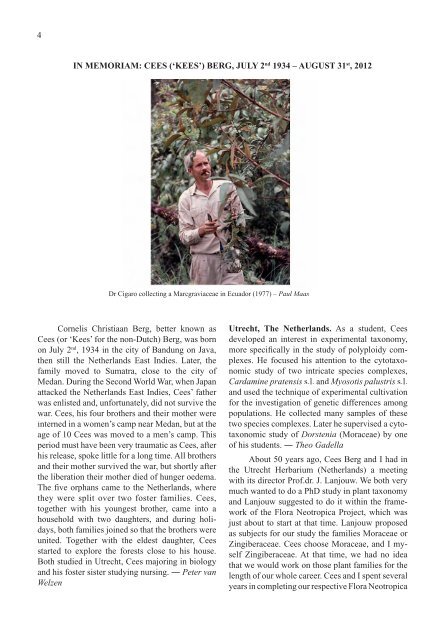Thai Forest Bulletin
Thai Forest Bulletin
Thai Forest Bulletin
You also want an ePaper? Increase the reach of your titles
YUMPU automatically turns print PDFs into web optimized ePapers that Google loves.
4<br />
IN MEMORIAM: CEES (‘KEES’) BERG, JULY 2 nd 1934 – AUGUST 31 st , 2012<br />
Dr Cigaro collecting a Marcgraviaceae in Ecuador (1977) – Paul Maas<br />
Cornelis Christiaan Berg, better known as<br />
Cees (or ‘Kees’ for the non-Dutch) Berg, was born<br />
on July 2 nd , 1934 in the city of Bandung on Java,<br />
then still the Netherlands East Indies. Later, the<br />
family moved to Sumatra, close to the city of<br />
Medan. During the Second World War, when Japan<br />
attacked the Netherlands East Indies, Cees’ father<br />
was enlisted and, unfortunately, did not survive the<br />
war. Cees, his four brothers and their mother were<br />
interned in a women’s camp near Medan, but at the<br />
age of 10 Cees was moved to a men’s camp. This<br />
period must have been very traumatic as Cees, after<br />
his release, spoke little for a long time. All brothers<br />
and their mother survived the war, but shortly after<br />
the liberation their mother died of hunger oedema.<br />
The fi ve orphans came to the Netherlands, where<br />
they were split over two foster families. Cees,<br />
together with his youngest brother, came into a<br />
household with two daughters, and during holidays,<br />
both families joined so that the brothers were<br />
united. Together with the eldest daughter, Cees<br />
started to explore the forests close to his house.<br />
Both studied in Utrecht, Cees majoring in biology<br />
and his foster sister studying nursing. ― Peter van<br />
Welzen<br />
Utrecht, The Netherlands. As a student, Cees<br />
developed an interest in experimental taxonomy,<br />
more specifi cally in the study of polyploidy complexes.<br />
He focused his attention to the cytotaxonomic<br />
study of two intricate species complexes,<br />
Cardamine pratensis s.l. and Myosotis palustris s.l.<br />
and used the technique of experimental cultivation<br />
for the investigation of genetic differences among<br />
populations. He collected many samples of these<br />
two species complexes. Later he supervised a cytotaxonomic<br />
study of Dorstenia (Moraceae) by one<br />
of his students. ― Theo Gadella<br />
About 50 years ago, Cees Berg and I had in<br />
the Utrecht Herbarium (Netherlands) a meeting<br />
with its director Prof.dr. J. Lanjouw. We both very<br />
much wanted to do a PhD study in plant taxonomy<br />
and Lanjouw suggested to do it within the framework<br />
of the Flora Neotropica Project, which was<br />
just about to start at that time. Lanjouw proposed<br />
as subjects for our study the families Moraceae or<br />
Zingiberaceae. Cees choose Moraceae, and I myself<br />
Zingiberaceae. At that time, we had no idea<br />
that we would work on those plant families for the<br />
length of our whole career. Cees and I spent several<br />
years in completing our respective Flora Neotropica
















